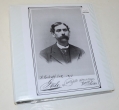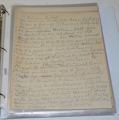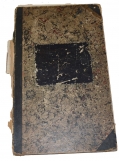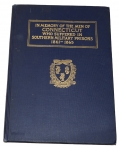site search
online catalog
CIVIL WAR JOURNAL OF ANDERSONVILLE SURVIVOR WILLIAM H. NOTT - 16TH CONNECTICUT VOLUNTEERS
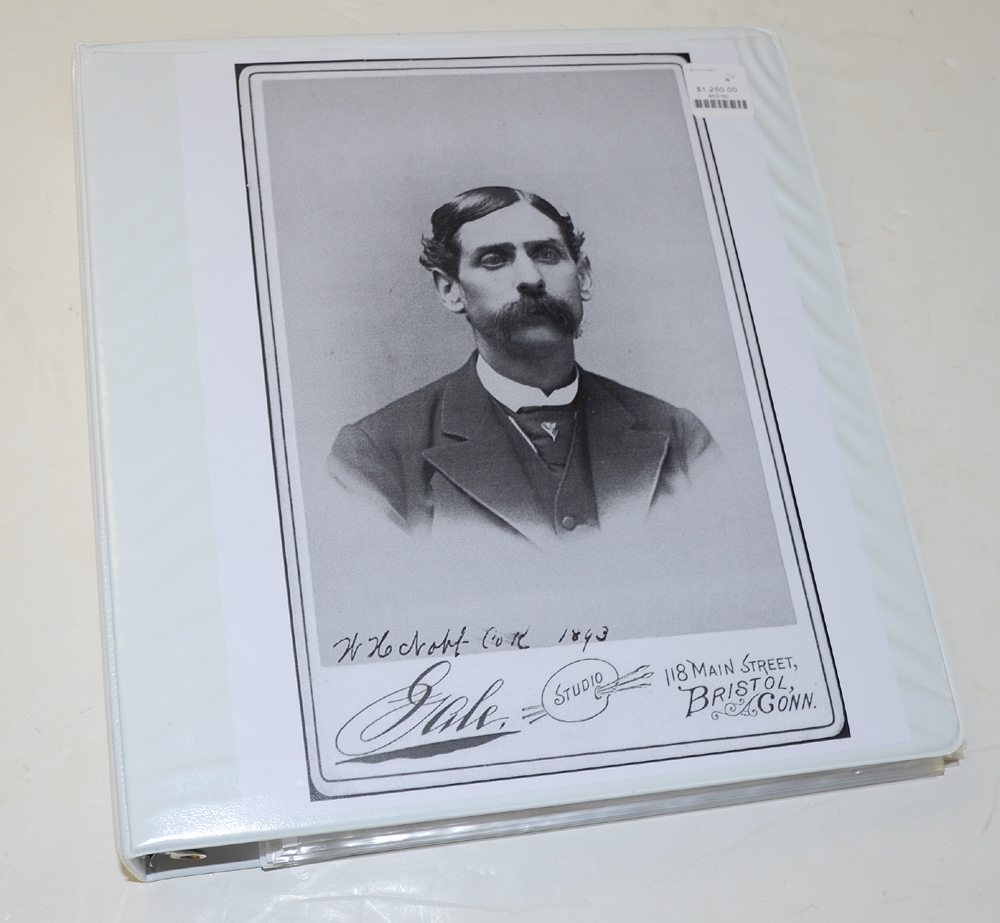
$750.00 SOLD
Originally $1,250.00
Quantity Available: None
Item Code: 453-50
This handwritten manuscript of 104 pages was penned by William H. Nott of Bristol, Connecticut from November 23, 1908 to April 30, 1909.
Nott summarizes his service as follows:
“Enlisted in Company K, 16th Conn. Vols. on July 22, 1862 as a Private. Mustered into US service August 24, 1862 to serve 3 years or during the war. Was in battle of Antietam Sept. 17. 1862. Was in the battle of Fredericksburg, and 2 engagements at Suffolk, Va. and battle of Plymouth, N.C. and was taken prisoner at that place when it was surrendered to the Rebels on April 24, 1864 and was taken to Andersonville (GA) and entered that place May 6, 1864 & was released Sept. 10th 1864 and was taken to Charleston, S.C. from there to Florence, S.C. from which place he was paroled Dec. 14, 1864 he was reduced to a skelatan when paroled. He was promoted to Corporal Dec. 25th 1862 to Sergeant April 20, 1863, to 1st Sergeant May 12th 1864-was discharged at New Berne, N.C. June 24th 1865 final discharge July 8th 1865 at Hartford, Conn.”
This memoir begins on a few pages from a ledger book that meas. approx. 8.00 x 13.75 inches. After 14 pages Nott switched to more conventional page sized sheets of paper. These have been arranged in numerical order inside sheet protectors and placed in a notebook with a modern copy of Nott’s civilian photo on the cover. All the pages within the notebook are the originals done in Nott’s own hand.
Nott’s descriptions are very detailed. He talks about his regiment going into battle at Antietam being very green. He speaks of one company being deployed as skirmishers even thought they had never performed this duty before. He also speaks of the death of his Captain and of the regiment being hit in the flank by A. P. Hill’s Division as it arrived from Harper’s Ferry. He mentions seeing the Hawkins Zouaves in action and in the end blames General McClellan for Lee’s escape back into Virginia.
On the march to Fredericksburg Nott relates passing a house with a woman standing in the doorway. As the soldiers passed Nott remembered the woman saying “You can march up those hills, meaning the hills back of Fredericksburg, but you will leave your bones there as you will find General Lee & Jackson up there all ready for you.” Nott goes on to say “She told the truth as many that was killed and wounded in the battle of Fredericksburg can testify though none of General Burnsides fault or his soldiers, but some blundering Generals under him that did not do their duty.”
Nott gives a several page description of the fight at Fredericksburg and mentions that around dusk as his regiment was moving forward he saw a Pennsylvania soldier kill himself. The man’s body was left where he lay after some of his own comrades rifled through the man’s pockets.
Throughout the memoir Nott relates stories of camp life and things that happened on the march and gives some particulars of his comrades. He describes the battles of Suffolk and his capture at Plymouth.
In regards to his capture Nott gives a very detailed account of the surrender at Plymouth and what he experienced on his trip through North Carolina to Andersonville.
Arriving at the famous prison on the evening of the 5th of May 1864, Nott and his fellow prisoners spent the night outside the stockade. In the morning a mounted officer approached them addressing them as “Damn Yanks.” Nott says of this officer “…he proved to be Captain Wirz of the so called Confederacy, a most villainous looking cuss as you would hardly ever set your eyes on.” Nott then describes being searched and separated into squads before entering the stockade.
Upon entering the prison Nott describes what he saw “When the heavy gates were opened what a sight met our eyes. Men that were once strong and healthy reduced to walking skilitans and almost naked and smoked and sunburnt, filth on the ground, a most miserable looking place to put a lot of men into. Some exclaimed is this Hell. We certainly thought we had struck the place and I now think that Capt. Wirz was a good representation of his satanic majesty…” Nott follows this with a detailed description of how the stockade was built and laid out. He describes the stream running through the camp as a “swamp” that “… was just one rolling tumbling mass of maggots and filth.” In the pages that follow life within the Andersonville stockade is described in detail with the narrative following through to Nott’s release and return to “God’s Country.”
With the memoir is some internet research on Nott as well as well as an original copy of the 1908 publication “IN MEMORY OF THE MEN OF CONNECTICUT WHO SUFFERED IN SOUTHERN MILITARY PRISONS 1861-1865: DEDICATION OF THE MONUMENT AT ANDERSONVILLE GEORGIA OCTOBER 23, 1907.”
This is a wonderful first rate memoir that should be annotated and published. [ad]
~~~~~~~~~~~~~~~~~~~~~~~~~~~~~~~~~~~
THIS ITEM, AS WITH ALL OTHER ITEMS AVAILABLE ON OUR WEB SITE,
MAY BE PURCHASED THROUGH OUR LAYAWAY PROGRAM.
FOR OUR POLICIES AND TERMS,
CLICK ON ‘CONTACT US’ AT THE TOP OF ANY PAGE ON THE SITE,
THEN ON ‘LAYAWAY POLICY’.
THANK YOU!
Inquire About CIVIL WAR JOURNAL OF ANDERSONVILLE SURVIVOR WILLIAM H. NOTT - 16TH CONNECTICUT VOLUNTEERS
For inquiries, please email us at [email protected]
Most Popular
Historical Firearms Stolen From The National Civil War Museum In Harrisburg, Pa »
Theft From Gravesite Of Gen. John Reynolds »
Cavalry Carbine Sling Swivel »
Fine Condition Brass Infantry Bugle Insignia »
featured item
EARLY WAR U.S. CAVALRY OFFICER’S SABER, 1840 STYLE, BY SMITH, CRANE AND COMPANY, NEW YORK, 1858 TO 1862
Smith, Crane and Company pieces are scarce. They were only in business from 1858 through 1862, retailing military goods in New York City. Their swords were imported, of German make and likely by Schnitzler and Kirschbaum, though not maker marked.… (870-263). Learn More »



